Want to catch Australian Bass this Spring in the Tuross River?
There’s something about spring that gets the blood pumping. The days get longer, the water warms up, and for those of us who love sport fishing, it means one thing: topwater season for adult Australian bass is here. The Australian bass is a highly sought-after sport fish, known for its power and appeal to anglers.
One place I’ll truly miss this spring is the stunning Tuross River in New South Wales, a hotspot for bass fishing enthusiasts. This is wild river fishing at its best, where Australian bass and estuary perch get aggressive, making it a prime time for ultralight fishing with artificial lures. The Tuross River features a mix of habitats, including streams and stream-like sections that provide ideal conditions for bass.
Whether you’re targeting fresh water species or just chasing the thrill of explosive action, spring brings some unforgettable moments on the water. Anglers can encounter a range of fish sizes, from small fish and juvenile bass to large adult fish, making each trip unique.
Introduction to the Tuross River
Nestled along the picturesque coastline of New South Wales, the Tuross River is a true gem for anyone passionate about bass fishing. This coastal river is renowned for its thriving population of wild Australian bass, or Macquaria novemaculeata, drawing anglers from across South Wales and beyond. The Tuross offers a diverse fishing experience, with its winding rivers, tranquil estuaries, and nearby freshwater dams providing a variety of habitats where bass can be found year-round.
What makes the Tuross River stand out is its ability to cater to all styles of fishing. Whether you prefer casting surface lures at dawn, working soft plastics along the edges, or experimenting with a range of artificial lures, there’s always a new challenge waiting.
The river’s mix of deep pools, shallow runs, and snag-filled banks means you can target bass in almost any condition, making every trip unique. For those looking to catch their first bass or seasoned anglers chasing that trophy fish, the Tuross River is a must-visit destination for unforgettable freshwater fishing adventures.
Gearing Up for Australian Bass in Spring: Lures for Every Situation
Spring is prime time for targeting bass, especially in shallow water. There’s nothing quite like casting a topwater lure near a snag in an estuary and watching a bass hit the surface with explosive energy.
That heart-in-your-mouth moment is what makes angling so addictive during this season. As the females prepare to spawn, they move closer to structure, making it the perfect time to pull out your ultralight fishing tackle and get casting. When selecting rods, consider the appropriate length and weight to match your lure and casting style—this helps with accurate presentation and effective long casts to reach distant structure or cover.
For the Tuross, my go-to topwater lures include hollow-bodied frogs, cicada imitations, pencils, and poppers. These lures create just the right surface disturbance to drive bass crazy under the warm spring sun. Fly fishing with surface flies is also a productive alternative for targeting bass, especially in overgrown or shallow areas.
But when the topwater bite isn’t happening, it’s time to switch strategies. A well-stocked tackle box is your best friend here. Spinnerbaits, beetlespins, and soft plastics rigged on worm hooks are ideal for pitching into thick cover like stumps, logs, or deep holes while avoiding snags.
Crankbaits and vibration baits are also essential tools for angling. While they’re better suited for clearer banks, rock walls, or laydown timber, they can be the perfect option when the bass are less active near the surface.
When working key areas, focus on presenting your lures in the strike zone to increase your chances of getting hooked up. Whether you’re fishing in estuaries or targeting females ready to breed, having the right rods and lures can make all the difference in your spring bass fishing adventures.
Moon and Time: Key Factors for Australian Bass Fishing Success
The moon often sparks debate among anglers—does it truly impact fishing? In my experience, the moon plays a significant role, particularly during the new moon phase.
This is when tidal movements are stronger, encouraging fish to move upstream in search of food as they travel in schools.
When it comes to timing, bass can be caught throughout the day, from pre-dawn to midday and even well after sunset. At night, Australian bass are generally less active, but they may still hunt prey in shallow water or at the water's surface.
That said, my preferred times are early morning or late afternoon, ideally when the tide is moving. These conditions often create the perfect opportunity to land your next big catch.
Four Lures to Tie On This Spring
If I had to pick a few specific lures to have ready for a trip to the Tuross, these would be on the list.
-
El Diablo:
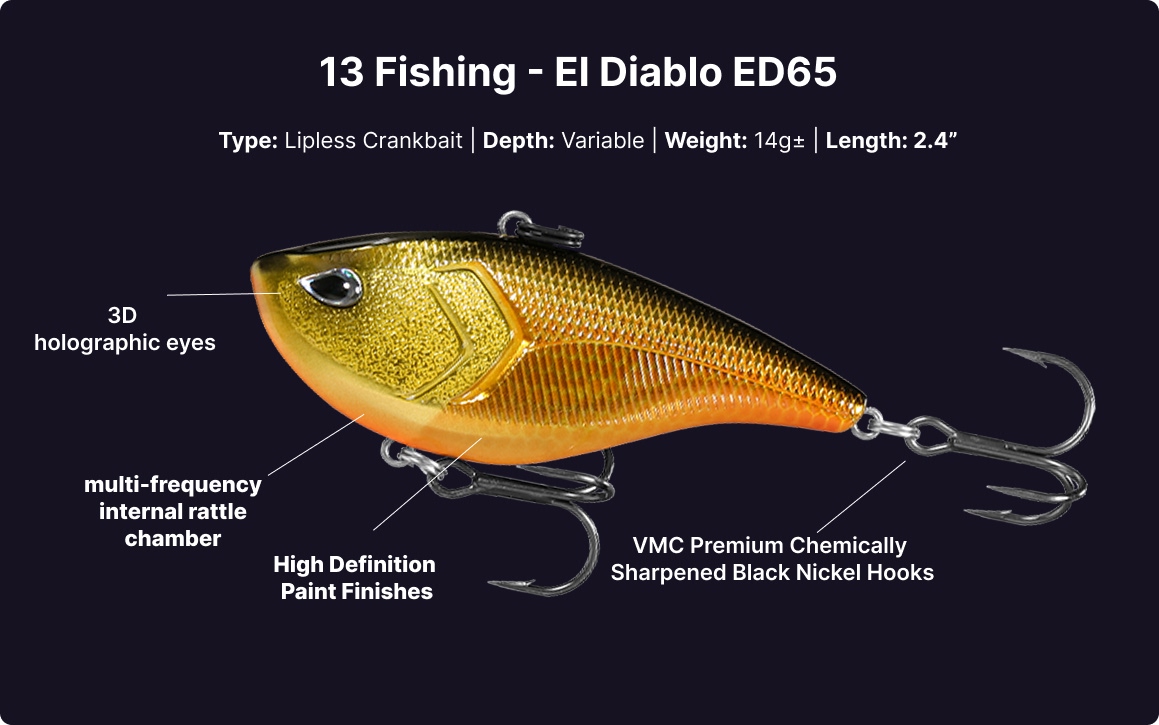
This is a seriously versatile lipless crankbait made by 13 Fishing. You can burn it fast over shallow flats, slow-roll it along the bottom in deeper sections, or use a yo-yo retrieve to get a reaction bite. It’s balanced to swim nose-down when it falls, which is great for minimizing hook tangles.The tight, rapid wobble sends out strong vibrations, and its internal rattle chamber calls fish in from a distance. With its lifelike paint jobs and 3D eyes, it just looks like a meal.
-
Heddon Tiny Torpedo®:

A classic surface lure for a reason. This little lure, with its rear prop, creates a commotion that makes it irresistible to Australian bass or estuary perch in coastal rivers.Perfect for ultralight fishing, you can work it with short twitches to make it splash and pop or retrieve it steadily to create a buzzing sound across the water’s surface, where bass often hunt and strike. Cast around trees for the best chance to catch fish. It’s an absolute killer early in the morning or late in the afternoon when the water is calm.
-
Malosi The Echo 65F:
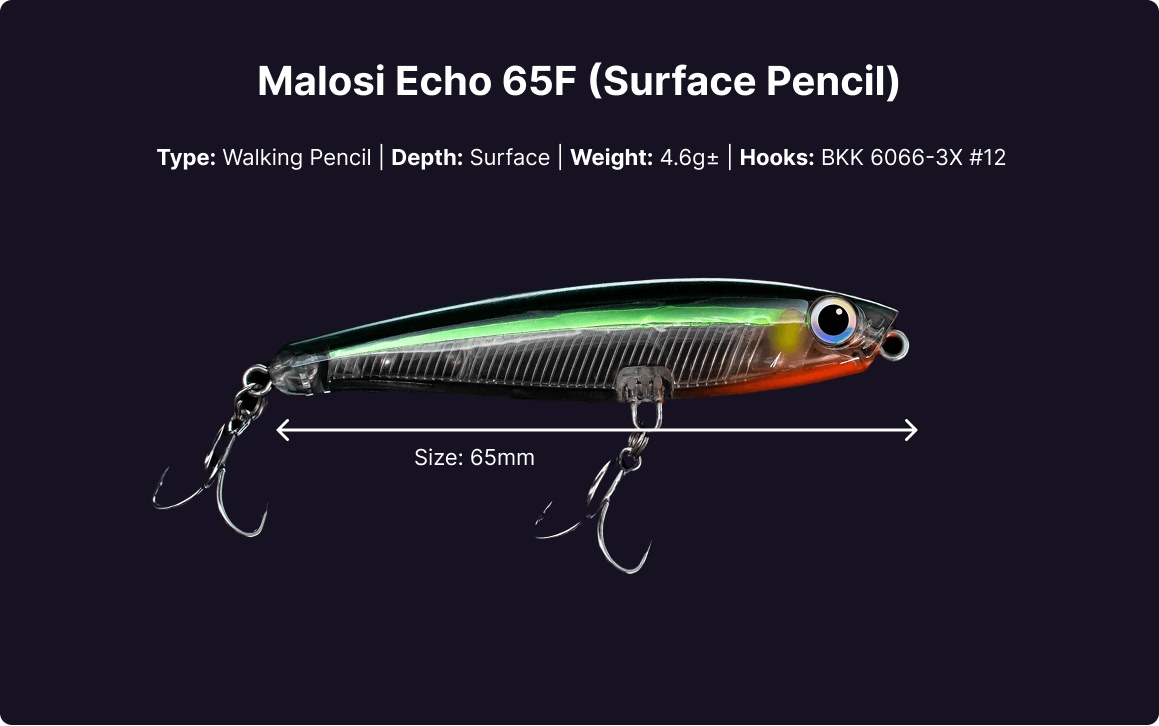
This is a fantastic floating stickbait, or “pencil,” that excels with a walk-the-dog retrieve. You can get it darting side-to-side across the surface, perfectly imitating a fleeing baitfish.It’s subtle enough not to spook wary fish but has enough presence to draw them out from cover for a spectacular surface strike.
-
Z-Man GrubZ™ with a Jig Spinner:
This is my go-to when the bite is tough. Rig a Z-Man GrubZ soft plastic on a jig head, and then add a small jig spinner blade to the front. The combination of the grub’s tail action and the flash and vibration from the blade is deadly. Its action can imitate crustaceans and aquatic insects, both of which are key components of the Australian bass's diet.It’s a great search bait you can cast at any type of structure, and it often convinces fish to bite when nothing else will.
Preparation and Safety for Spring Bass Fishing
With the arrival of spring, the excitement for bass fishing on the Tuross River ramps up, and it’s important to be well-prepared before you hit the water. Start by checking the latest weather conditions and river levels to ensure a safe and enjoyable outing. Make sure you have the appropriate fishing permits and are up to date with local regulations, as these can change seasonally and help protect the bass populations for future generations.
Safety should always be a top priority, especially when fishing in areas known for strong currents, submerged snags, and hidden obstacles. Wearing a life jacket is a must, particularly if you’re fishing from a kayak or small boat, and protective clothing can help shield you from the sun and unexpected scrapes. Take extra care when navigating around snags and structure, as these are prime spots for bass but can also pose risks to anglers and gear.
Lastly, remember to respect the river and its surroundings. Dispose of any waste responsibly, avoid disturbing sensitive habitats, and be mindful of your impact on the environment. By preparing properly and fishing responsibly, you’ll not only increase your chances of a great catch but also help preserve the Tuross River’s natural beauty for everyone to enjoy.
Tactics for Stalking Australian Bass in the Tuross River
When I’m out on the water, it’s tempting to paddle or motor around, trying to cover as much ground as possible in search of fish.
But over the years, I’ve learned that some of the best opportunities are often right at my feet. My number one piece of advice? Slow down and thoroughly work key areas like undercut banks, white edges, and deep water.
These spots often hold fish in specific strike zones, so don’t just toss a couple of casts and move on.
I make it a point to cover every nook and cranny of a structure. I’ll cast from different angles, change my retrieve speed, and keep at it until I figure out what the fish—regardless of species—are generally drawn to and how they want to feed.
Once I get a bite, it often reveals a pattern. Sometimes I’ll pull multiple fish from a single log, rock wall, or eddy, as they tend to stack up in predictable spots during feeding or even while preparing to spawn. Australian bass can sometimes be found in large schools, especially during feeding or spawning periods, making these locations even more productive.
That said, fishing conditions are never static. The bite can shut off in a heartbeat due to changes in cloud cover, wind direction, barometric pressure, or even the sun shifting position.
When that happens, it’s time to switch things up. I’ll experiment with different lures, tactics, and approaches to adapt to the evolving conditions. That constant puzzle—the shifting behaviors and strike zones of wild river fish—is what keeps me coming back.
FAQ
-
What fish can you catch in the Tuross River?
The Tuross River is home to a variety of fish species, including Dusky Flathead, Southern Black Bream, Australian Bass, Mullet, Estuary Perch, Whiting, and Golden Perch. According to NSW’s Department of Primary Industries, the upper reaches of the river even support trout populations. In fact, all waters and tributaries upstream of Tuross Falls are classified as trout waters. Stockings of Australian Bass and other species occur in some dams within the region.
-
What’s the best bait for Australian Bass in spring?
In spring, Australian Bass are highly responsive to surface lures, especially those that imitate cicadas or other insects skimming the water’s surface. Artificial lures like small hard-bodied crankbaits or vibration baits mimicking bugs, as well as soft plastics resembling baitfish or yabbies, are excellent choices. Scrub worms are also a natural bait option that can be very effective. To increase your catch, fish these baits near structures like fallen timber or submerged branches
-
Where can you catch Australian Bass in the Tuross River?
To target Australian Bass in the Tuross River, focus on the freshwater and brackish zones above the tidal estuary. These fish are commonly found near structures like submerged logs, overhanging trees, and rocky outcrops where they wait to ambush prey. Additionally, the middle and upper reaches of the river, as well as nearby streams and some dams, are great spots to find both Australian Bass and Estuary Perch. Stocking programs have introduced bass to certain impoundments and dams in the area.
-
What is the legal size for keeping Australian Bass?
The legal size for keeping Australian Bass in NSW is a minimum of 30 cm. This regulation helps protect juvenile bass and ensures sustainable populations by allowing fish to reach sexual maturity before being harvested.
-
What lure colors are best for Australian Bass?
When fishing for Australian Bass, clear water calls for natural, subtle hues such as green flakes or Bad Shad. In murky or low-light conditions, opt for darker shades like black or bright colors like chartreuse to create contrast and visibility. Glittered or solid colors work well in cloudy water to catch the fish’s attention, while metallic or holographic finishes can be especially effective on sunny days. Australian Bass can be identified by their anal and pelvic fins, which often have distinctive white edges.
The Final Cast for Wild Australian Bass or Estuary Perch
While I find myself up north these days, I'll definitely miss stalking those wild river bass on the Tuross this spring.
The stunning scenery, the challenge of the hunt, and the thrill of a topwater explosion are experiences that stay with you. So if you get the chance, get out there, tie on a frog or a popper, and work those banks thoroughly. You might just connect with the fish of a lifetime.







.png)


 1.png)
 1.png)





.png)
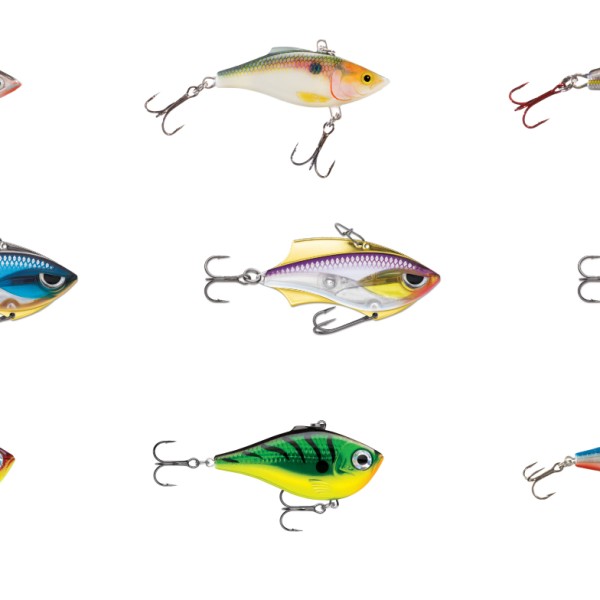
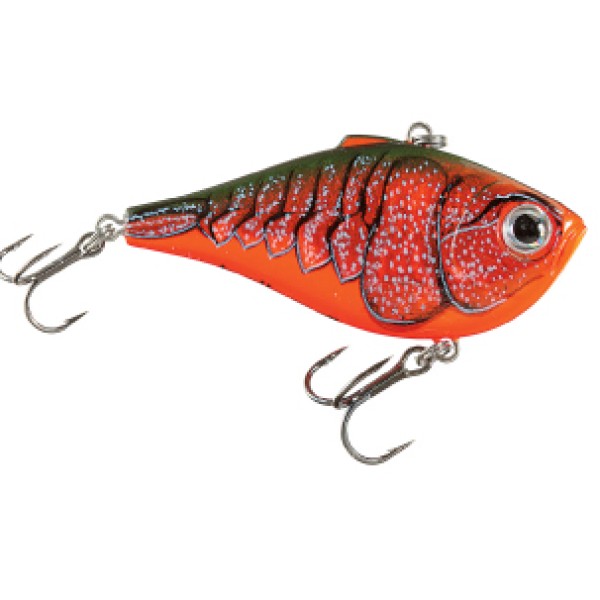
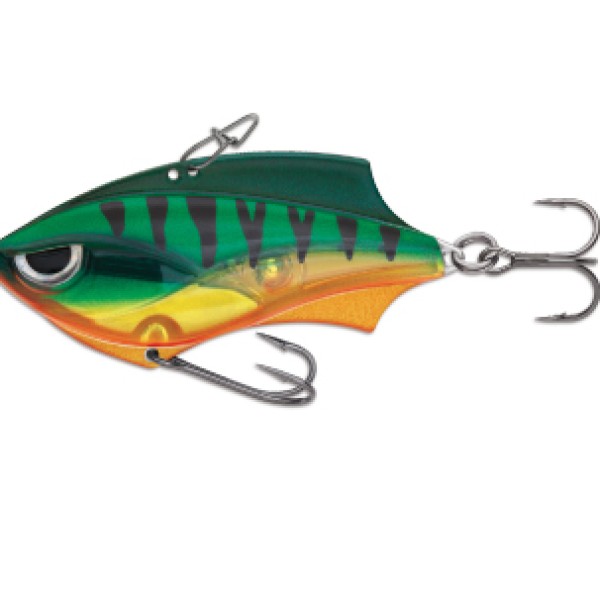
 Newsletter
Newsletter

